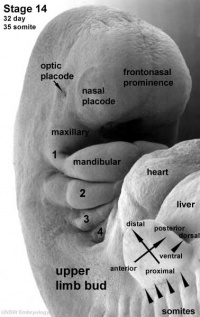2012 Group Project 1: Difference between revisions
No edit summary |
No edit summary |
||
| Line 10: | Line 10: | ||
==Development== | ==Development== | ||
Eyes initially form laterally from the paired ectodermic optic placodes and migrate medially in the human embryo. In other animals such as birds and lizards, the eyes do not migrate and develop laterally on the head. The optic placodes become prominent at approximately Stage 14 of development. | Eyes initially form laterally from the paired ectodermic optic placodes and migrate medially in the human embryo. In other animals such as birds and lizards, the eyes do not migrate and develop laterally on the head. The optic placodes become prominent at approximately Stage 14 of development and contribute the lens to the eye. | ||
[[File:Stage14 sem2b-limb.jpg|200px|thumb|right|A Stage 14 embryo showing the location of an otic placode.<ref>http://embryology.med.unsw.edu.au/embryology/index.php?title=ANAT2341_Lab_6_-_Early_Embryo</ref>]] | [[File:Stage14 sem2b-limb.jpg|200px|thumb|right|A Stage 14 embryo showing the location of an otic placode.<ref>http://embryology.med.unsw.edu.au/embryology/index.php?title=ANAT2341_Lab_6_-_Early_Embryo</ref>]] | ||
| Line 22: | Line 22: | ||
===Lens=== | ===Lens=== | ||
The lens has its origin from the optic placode, which develops on the ectodermic surface of the embryo and migrates both medially and inwards into the embryo. | |||
===Aqueous Chambers=== | ===Aqueous Chambers=== | ||
Revision as of 11:15, 29 August 2012
Vision Development
--Mark Hill 12:20, 15 August 2012 (EST) This is a better title.
Introduction
Eyes are an important sensory organ shared across many different species and allow organisms to gather useful visual information from their environment.
Research history
Development
Eyes initially form laterally from the paired ectodermic optic placodes and migrate medially in the human embryo. In other animals such as birds and lizards, the eyes do not migrate and develop laterally on the head. The optic placodes become prominent at approximately Stage 14 of development and contribute the lens to the eye.

Retina
Ciliary Body
Iris
Lens
The lens has its origin from the optic placode, which develops on the ectodermic surface of the embryo and migrates both medially and inwards into the embryo.
Aqueous Chambers
Cornea
Choroid and Sclera
Eyelids
Lacrimal Glands
Extraocular muscles
Current research
Useful links
Glossary
Image gallery
References
External Links
External Links Notice - The dynamic nature of the internet may mean that some of these listed links may no longer function. If the link no longer works search the web with the link text or name. Links to any external commercial sites are provided for information purposes only and should never be considered an endorsement. UNSW Embryology is provided as an educational resource with no clinical information or commercial affiliation.
--Mark Hill 12:22, 15 August 2012 (EST) Please leave the content listed below the line at the bottom of your project page.
2012 Projects: Vision | Somatosensory | Taste | Olfaction | Abnormal Vision | Hearing